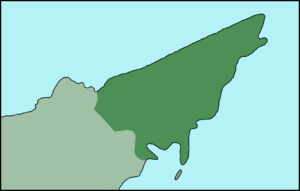Oroshan Peninsula
This article is incomplete because it is pending further input from participants, or it is a work-in-progress by one author. Please comment on this article's talk page to share your input, comments and questions. Note: To contribute to this article, you may need to seek help from the author(s) of this page. |
 | |
| Area | 480,000 km2 |
|---|---|
| Population | 2,000,000 |
| Population density | 4.167/km2 |
| Countries | Oroshia |
The Oroshan peninsula of eastern Surucia is bounded by the Demontean Ocean in the south and east, whose major bays on the peninsula include Ol-omol Bay and Kavyin Bay. To the north, it is bounded by the Northern Ocean, and to the west it is demarcated by the Bangvel River in the south, and the edge of the Shizumutochi Bay drainage basin in the north. Altogether, the peninsula covers around 480,000 km2, and is nearly coterminous with the country of Oroshia, with the exception of the Shizumutochi Bay drainage basin, which is not included in the peninsula. The peninsula is centred around the Gyo-chin Mountains, and off the continental shelf, 200 km to the southeast, there is a deep oceanic trench.
Around 2,000,000 people live on the peninsula, including Oroshans, Namchogis, Yvlipkans, and, more recently, Jogins. The peninsula was a site of extensive glaciation during the most recent glacial maximum, owing to the climate and elevation, conducive for glacier formation.
Names
The peninsula is called Papvək kikŋaʔvs in Oroshan, also meaning "Oroshan peninsula". The same is used in Jogin, where the name for the peninsula is 양치기 반도, transliterated yangchigi bando. In Yvlipkan and Namchogi, it is referred to as "the forested peninsula", or "the peninsula of trees", despite Yvlipkan being related to Oroshan and not Namchogi. In Yvlipkan, the name is Pəbwək ipŧ, from ip, "tree"; and in Namchogi it is Xuutgəət ŋggit, from ŋŋit, also "tree".
Demographics
The peninsula's 2 million inhabitants are concentrated around the coast, with the Namchog people mostly occupying the interior mountains. The population is largely made of up Oroshans, and the capital city of Oroshia, Sochvel, is the peninsula's largest city. The peninsula has been traversed by rail since the early 1920s, owing to the period of Jogin colonization. There are several airports, the largest of which is Itikavəŋ Kiłino International Airport in Sochvel. In the winter, the northern coast is normally inaccessible by boat due to ice, so most goods are transported overland.
Geology
The backbone of the peninsula is made up of the Gyo-chin Mountains, which formed roughly 250 million years ago, during the Triassic period in a period of crustal subduction, in which the Demontean plate subducted underneath the Surucian plate. This geologic event is known as the Oroshan orogeny, and is responsible for the creation of the Oroshan geologic province, which also extends further south of the peninsula. The rocks making up the mountains are a mix of sedimentary shales and igneous granites, which were then folded up in the orogeny. Analyses of the rocks put a tentative date for their formation at ~525 million years ago, during the early Paleozoic era for the sedimentary rocks, and ~2.1 billion years ago in the Proterozoic eon for the granite. The sedimentary rocks had probably once overlain the original granite bedrock, but due to the unequal folding of the crust during mountain building and subsequent glaciation, much of the shale has been eroded, exposing the granite underneath. The highest peak on the peninsula is Kəvkəvəvi vaŋaŋč.